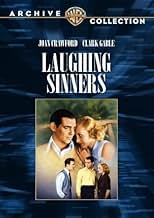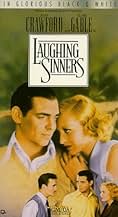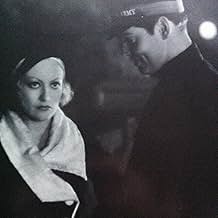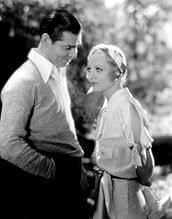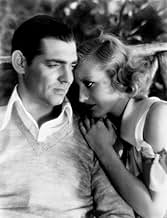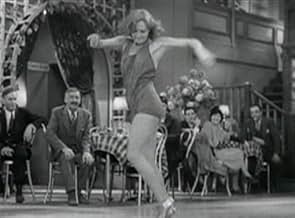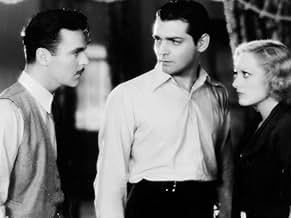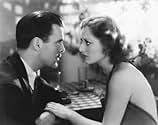A Salvation Army worker recruits a suicidal cafe dancer.A Salvation Army worker recruits a suicidal cafe dancer.A Salvation Army worker recruits a suicidal cafe dancer.
- Director
- Writers
- Stars
- Awards
- 1 win total
Henry Armetta
- Tony
- (uncredited)
Jack Baxley
- Waiter
- (uncredited)
Clara Blandick
- Salvation Army Woman
- (uncredited)
Sherry Hall
- Poker-Playing Salesman
- (uncredited)
Tenen Holtz
- Poker-Playing Salesman
- (uncredited)
Mary Ann Jackson
- Betty
- (uncredited)
Karen Morley
- Estelle Seldon (photo in newspaper)
- (uncredited)
- Director
- Writers
- All cast & crew
- Production, box office & more at IMDbPro
Featured reviews
The second film that had Clark Gable and Joan Crawford together didn't start out that way. Laughing Sinners started out with Johnny Mack Brown as the Salvation Army Worker who saves Crawford and the film was completed when Louis B. Mayer saw the film and said reshoot it with Gable. This was after having seen them together in Dance Fools Dance where Gable was a villain and had only a couple of scenes with Crawford. This is according to Joan herself in a tribute she wrote in the Citadel Film Series Book, The Films of Clark Gable.
Crawford is definitely in her element as singer/dancer and good time Prohibition party girl who falls for the charms of Neil Hamilton, a traveling salesman. You know what a bunch of party animals they are, just ask Arthur Miller. Anyway Hamilton decides though he thinks Joan's great in the hay, he wants to marry the boss's daughter and does, leaving her flat and despondent.
One night as she's ready to throw herself off a bridge, Salvation Army worker Clark Gable stops her. She likes him, but still has a yen for Hamilton and he, her.
Given Clark Gable's later image the casting of him as a Salvation Army worker is ludicrous. Mayer knew that and during the course of the film he gives him a nice prison background before he joined Edwin Booth's Army. The only way Gable could possibly fit the part. Anyway Mayer did it for the obvious chemistry between Gable and Crawford.
It's more Joan's picture than his though. Later on her talents as a dancer which brought her to film in the first place would be not seen at all. So Laughing Sinners is a treat in that way.
The film is based on a Broadway play Torch Song which ran for 87 performances the year before and starred Mayo Methot, Reed Brown, and Russell Hicks in the parts that Crawford, Hamilton, and Gable have. Coming over from the Broadway cast is Guy Kibbee in the role of another salesman, the only one to repeat his role from Broadway. Roscoe Karns and Cliff Edwards play another pair of salesmen and Marjorie Rambeau is Crawford's party girl friend.
Russell Hicks is definitely more my idea of a Salvation Army worker, but Gable's more my idea of a leading man opposite Joan Crawford.
Crawford is definitely in her element as singer/dancer and good time Prohibition party girl who falls for the charms of Neil Hamilton, a traveling salesman. You know what a bunch of party animals they are, just ask Arthur Miller. Anyway Hamilton decides though he thinks Joan's great in the hay, he wants to marry the boss's daughter and does, leaving her flat and despondent.
One night as she's ready to throw herself off a bridge, Salvation Army worker Clark Gable stops her. She likes him, but still has a yen for Hamilton and he, her.
Given Clark Gable's later image the casting of him as a Salvation Army worker is ludicrous. Mayer knew that and during the course of the film he gives him a nice prison background before he joined Edwin Booth's Army. The only way Gable could possibly fit the part. Anyway Mayer did it for the obvious chemistry between Gable and Crawford.
It's more Joan's picture than his though. Later on her talents as a dancer which brought her to film in the first place would be not seen at all. So Laughing Sinners is a treat in that way.
The film is based on a Broadway play Torch Song which ran for 87 performances the year before and starred Mayo Methot, Reed Brown, and Russell Hicks in the parts that Crawford, Hamilton, and Gable have. Coming over from the Broadway cast is Guy Kibbee in the role of another salesman, the only one to repeat his role from Broadway. Roscoe Karns and Cliff Edwards play another pair of salesmen and Marjorie Rambeau is Crawford's party girl friend.
Russell Hicks is definitely more my idea of a Salvation Army worker, but Gable's more my idea of a leading man opposite Joan Crawford.
Oh, boy. Clark Gable in the Salvation Army. Where did they come up with this stuff? Nightclub performer Ivy Stevens (Joan Crawford) is despondent upon learning Howard "Howdy" Palmer (Neil Hamilton) has no intention of marrying her. She was just a booty call to our boy Howdy. How Neil Hamilton got so many roles in the early '30s as a ladies man type is beyond me but that's how it was then I guess. Anyway, Ivy decides to jump off a bridge but she is stopped by kindly and handsome Salvation Army worker Carl (a mustacheless Clark Gable). Ivy joins up with the Salvation Army too and is seemingly happy with her new lifestyle. But then one day Howdy spots her and, despite being married now, makes a move for her. Can Ivy resist Howdy's seductive ways? Can any woman?
There's a few things wrong with this movie. First, on no planet does Joan freaking Crawford, at this time a young and sexy dancer, get that upset over being dumped by Neil Hamilton. He was born looking like a banker. So that's unbelievable. Second and third things are that Clark Gable is no Salvation Army worker and he sure as hell isn't a guy named Carl! Joan's farmer dance is the highlight of the movie and probably her best dancing number from all of her early dancing movies. Overall it's a watchable but mostly forgettable melodrama about a "wrong" woman going right. Avid Crawford and Gable fans will like it most.
There's a few things wrong with this movie. First, on no planet does Joan freaking Crawford, at this time a young and sexy dancer, get that upset over being dumped by Neil Hamilton. He was born looking like a banker. So that's unbelievable. Second and third things are that Clark Gable is no Salvation Army worker and he sure as hell isn't a guy named Carl! Joan's farmer dance is the highlight of the movie and probably her best dancing number from all of her early dancing movies. Overall it's a watchable but mostly forgettable melodrama about a "wrong" woman going right. Avid Crawford and Gable fans will like it most.
A lot of interesting bits in this. O'Henry bars in 1931?! Reference to the Fresh Air taxi? Acting very good throughout, especially Neil Hamilton who was a real sleazeball. Joan Crawford, who I was never a big fan of, was very pretty, certainly better thas in "This Modern Age" (same year) and almost to her Lucille La Seur standards. The 2nd half was better than the 1st, but they, as was common then, always ended the movie too abruptly. Most revealing was the scene early on in which a bunch of kids were playing in the park, boys & girls. Some were black some were white. Then the religious right and their Code came along after which blacks were only portrayed as servants, buffoons and dullards.
One of those movies about fallen women who reform that were common in pre-Code Hollywood, LAUGHING SINNERS, also known as COMPLETE SURRENDER, comes less as a movie of quality as standard fare that features the two leads, Crawford and Gable -- she already a star, he a rising actor -- coming together and making early music to the viewer's eyes. Before Hepburn and Tracy, these were the ones the public wanted to see together even if the movie in itself was less than memorable, and MGM gave it to them 8 times.
Also a feature where one can get to see Crawford dance, sing, and indirectly, essay what would become a breakout role in RAIN only a year later.
Also a feature where one can get to see Crawford dance, sing, and indirectly, essay what would become a breakout role in RAIN only a year later.
"Laughing sinners" was a pleasant surprise to me. I never knew what a good actress Joan Crawford was until I saw this film. I saw her rather exaggerating performance in "Grand Hotel", and a better performance in 1931's "Possessed", but here she is totally convincing and real. There are moments of great beauty, especially the scenes between Crawford and Clark Gable, moments when the film shows a timeless quality. Gable and Crawford are completely believable as the Salvation Army officers : sincere, vulnerable and intense. Clark Gable in a very unusual role - wise, calm, sensitive and understanding - It makes him powerful in a subtle way. Neil Hamilton is terrific especially in the scene - a very long uninterrupted take ! - when he tries to persuade and seduce Joan Crawford - for a night of bliss. Can he offer her salvation ?
Did you know
- TriviaModern sources state that a preview of the film had such a bad reception that M-G-M production head Irving Thalberg decided to re-shoot part of the picture, dropping Johnny Mack Brown as Carl and re-shoot it with Clark Gable. At that point, Brown's career in mainstream feature films at MGM ended and he transitioned to 'B' westerns.
- GoofsOne year after Howard marries his wealthy boss's daughter he is still a traveling salesman, staying in cheap hotels. The only reason for him to do so is in order for him to meet Ivy again, but it is absurd that his socialite wife would want her husband doing such a job. He could have encountered Ivy in some other way.
- Quotes
Man Boarding Train: [annoyed and impatiently waiting to get by a kissing Ivy and Howdy] Well, anytime you get through.
Ivy 'Bunny' Stevens: Mister, we never get through.
- ConnectionsFeatured in Fast Workers (1933)
- Soundtracks(What Can I Do?) I Love That Man
(uncredited)
Music by Martin Broones
Lyrics by Arthur Freed
Sung by Joan Crawford at the cabaret
Details
- Release date
- Country of origin
- Languages
- Also known as
- Complete Surrender
- Filming locations
- Production company
- See more company credits at IMDbPro
Box office
- Budget
- $338,000 (estimated)
- Runtime
- 1h 12m(72 min)
- Color
Contribute to this page
Suggest an edit or add missing content

